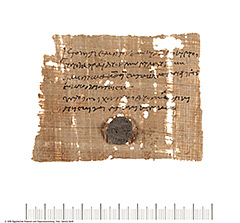BGU III 718 (P. 7882)
„Small but nice“ – that could probably be said about this papyrus. Because this small and unimpressive tax receipt has to offer some special surprises that only catch the eye when you look closely.
The papyrus was found in the Fayum, belonged to the collection of the Egyptologist Heinrich Brugsch and came to the Berlin papyrus collection in 1891. He is almost completely preserved. On the front, the recto, six lines have been preserved, of which only small parts of individual letters are lost, and a seal imprint underneath. The back, the verso, is blank.
From the text we learn more about its origin. He comes from Soknopaiu Nesos, as we can read in line 4. This ancient village was located on the north side of the Lake Moeris in the Fayum and was famous for its large temple of the crocodile god Soknopaios. In addition, the text begins with a date, which converted into our today’s date system equals the 25th of March of the year 102 AD.
In the text it is confirmed that Satabus, the son of a Nestnephis, has paid the tax for a sacrificial calf. Furthermore, it is stated that the sacrifice took place on the 25th of March. This receipt has been issued directly for this day. About the sacrificial animal, we learn nothing directly. The designation of the tax as „a tax for a sacrificial calf sacrificed to that date in Soknopaiu Nesos“ may suggest that it was a calf, but this term for the animal is also used for young oxen in other texts.
About the taxpayer we have no further direct information. In this text we only learn that Satabus is the son of Nestnephis and lives or works in Soknopaiu Nesos. A title is not specified for him. From parallel texts where we have more information about the taxpayer, it can be seen that the taxpayer of this tax for a sacrificial calf was the priest who performed the sacrifice. Thus, Satabus pays the tax for a sacrificial calf, which he sacrificed himself. The reason for this levy is that the sacrificing priest received income from the animal he slaughtered, which was thus taxed.
Nothing is said about the amount of this payment, from which one may conclude that there may have been a fixed amount to be paid. It is interesting that in all known receipts for this tax it is always only a certain one-time sacrifice which was taxed. It was not paid as flat-rate or total for a whole year, but separately for each sacrifice. In this text it was paid for the sacrifice on the 25th March 102 AD.
If this text is thus already very interesting in terms of content, it also has something to offer externally. The peculiarity of this papyrus is probably the sealing impression made of clay, which was fixed on the papyrus under the text. It shows a crocodile with the head of a hawk. This is the usual representation of the crocodile god Soknopaios, the god of Soknopaiu Nesos. In this case, he stands on a snake which he has defeated. The text, which is to be read in the circle around this representation, contains a year in the then usual form: the fifth year of the reign of the Roman Emperor Trajan, as it was already mentioned in the text. Apparently here we have the imprint of an official stamp of Soknopaiu Nesos used for this year.



